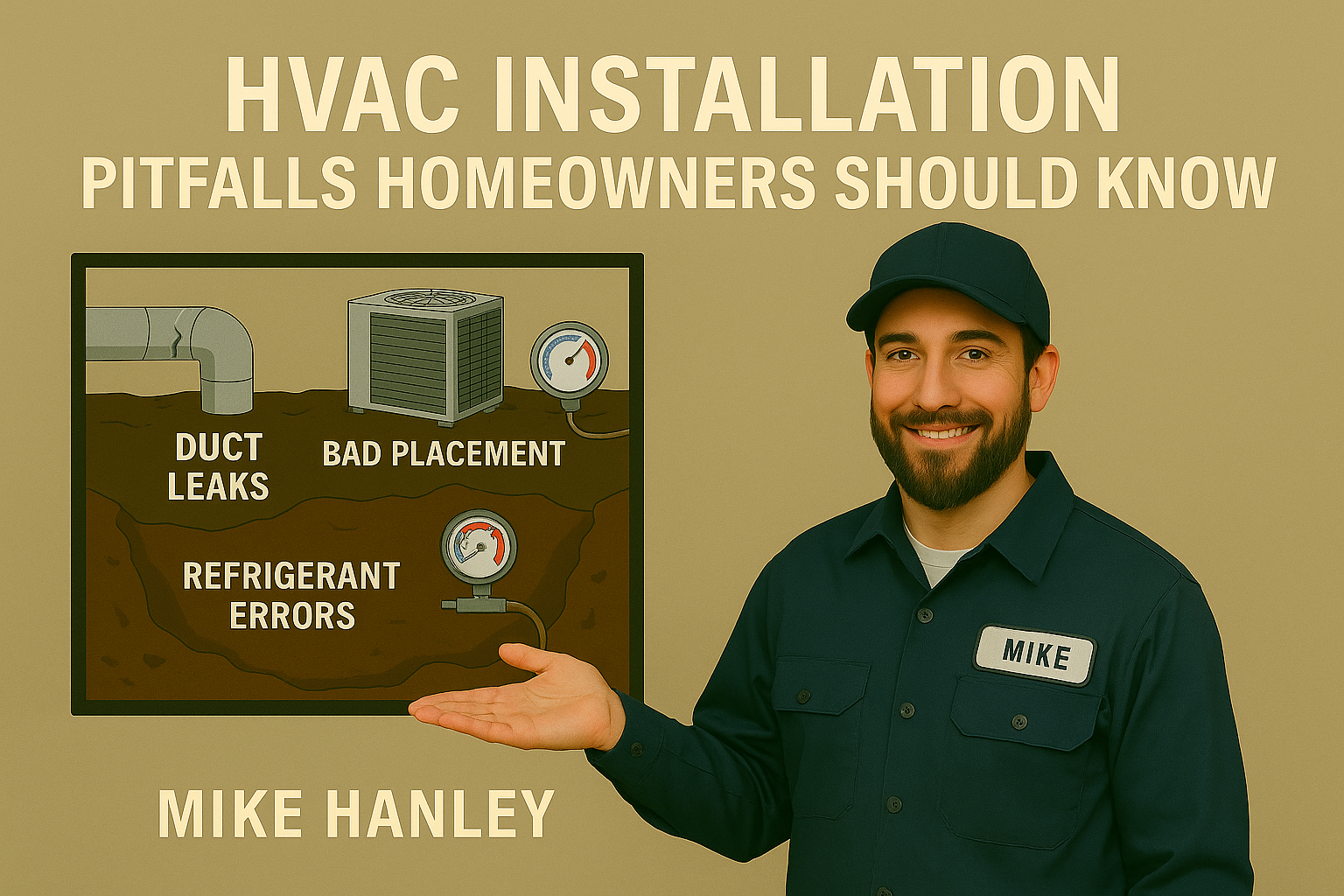📘 Table of Contents
🏡 Why Proper Installation Matters
Even the best HVAC systems can't perform effectively if installation isn't done right. Common errors like poorly sealed ductwork, incorrect refrigerant levels, or inadequate sizing can dramatically reduce efficiency, shorten the lifespan of your equipment, and even void warranties.
By recognizing and avoiding these frequent installation mistakes, you can ensure your HVAC system delivers optimal comfort, energy savings, and reliable performance year after year.
📏 Common Pitfalls and Solutions
Homeowners frequently encounter HVAC installation mistakes that can easily be avoided. Here are the most common errors along with practical solutions.
1. Skipping Permits and Load Calculations
Mistake: Installing without obtaining permits or conducting a Manual J load calculation.
Impact: Incorrect sizing, inconsistent temperatures, code violations.
Solution:
-
Always perform a Manual J Load Calculation to determine correct unit size.
-
Ensure licensed contractors secure required permits. See our Central AC Installation Guide for step-by-step details.
2. Ductwork Issues
Mistake: Leaky, improperly sized, or poorly installed ductwork.
Impact: Energy loss (up to 30%), uneven airflow, and increased energy bills.
Solution:
-
Seal ducts using mastic and conduct professional airflow testing.
-
Consider a duct retrofit as outlined in DOE’s Duct Sealing Guide.
3. Incorrect Refrigerant Charge
Mistake: Overcharging or undercharging the refrigerant.
Impact: Coil freeze-ups, compressor stress, reduced system life.
Solution:
-
Accurately measure refrigerant using scales, adhering strictly to manufacturer guidelines.
-
Refer to Jake’s comprehensive advice in our blog Avoiding Common R-32 Installation Pitfalls.
4. Electrical & Venting Errors
Mistake: Incorrect electrical wiring or improper condensate drain installation.
Impact: Frequent breaker trips, potential water damage, fire hazards.
Solution:
-
Match minimum circuit amperage (MCA) requirements with correct wiring gauge.
-
Properly slope condensate drains with adequate traps per installation codes.
5. Poor Outdoor Placement
Mistake: Installation on uneven surfaces or insufficient clearance.
Impact: Reduced efficiency, vibration damage, early system failure.
Solution:
-
Install outdoor units on level pads with at least 24 inches of clearance.
-
Slightly tilt the unit away from your home for effective drainage and vibration management.
⚠️ Hidden Costs of Mistakes
Incorrect HVAC installations involve hidden costs that extend far beyond initial installation expenses:
-
Energy Waste: Faulty installation can increase energy bills by over 20% annually.
-
Additional Repairs: Refrigerant corrections or duct repairs add hundreds of dollars in labor and materials.
-
Warranty Voids: Manufacturers, including Goodman, require professional installation documentation to honor warranty claims.
Careful record-keeping and proper labeling during installation mitigate these hidden expenses.
🔒 When Permissions & Documentation Save You
Skipping permits or documentation can lead to serious financial and legal consequences:
-
Fines or failed home inspections.
-
Increased homeowner insurance premiums.
-
Voided equipment warranties.
Ensure your contractor obtains all necessary permits, employs licensed labor, and registers warranties. For detailed guidelines, refer to our Central AC Installation Guide.
📚 Real-World Case Examples
HVAC installation mistakes often feel like something that happens to “other people” until they happen to you. These real-world examples highlight just how easy it is for small oversights to cause major system problems or safety hazards.
-
Uninspected Install in a New Home:
A homeowner moved into a newly constructed property only to find uneven airflow and hot zones in key rooms. It turned out the contractor skipped a Manual J calculation and used undersized ducts for the second floor. This error led to poor comfort, constant runtime, and eventually a complete duct overhaul costing thousands. Learn why proper sizing matters from the Building America Solution Center. -
DIY Refrigerant Mishap:
In an effort to save money, one homeowner attempted to recharge their HVAC system using a DIY refrigerant kit from a hardware store. Unfortunately, the unit was overcharged, causing the compressor to overheat and fail. Since the unit wasn’t serviced by a certified technician, the manufacturer voided the warranty. Read more about the risks of improper refrigerant at Energy Star.
Mistakes like these are more common than you think and they're usually preventable with the right knowledge and certified professionals.
✅ Key Takeaways & What to Read Next
Proper installation is essential for HVAC performance, savings, and durability. Avoid these installation pitfalls by hiring licensed professionals, sealing ducts correctly, and documenting every step.
This article is the second part of our Top HVAC Mistakes Homeowners Make series. Continue learning:
➡️ Next: Eliminating HVAC Sizing Errors: A Complete Guide
🔙 Back to Main Topic: Top HVAC Mistakes Homeowners Make
❓FAQ
Q: Is a Manual J really required?
A: Yes. Energy.gov recommends load calculations for right-sizing HVAC systems.
Q: Can I seal my ductwork myself?
A: Only if you have tools and training. Most homeowners should hire pros for precise sealing and airflow testing.
Q: What’s the risk of DIY refrigerant charging?
A: Over-charging can freeze coils; under-charging damages compressors. Always use proper gauges and tools.
Q: Do I need permits for HVAC?
A: Definitely. Permits protect both homeowner and installer, and are required for inspections and warranty compliance.
Q: How long should duct sealing last?
A: Properly sealed ducts should last 10–20 years, assuming quality materials and workmanship.







